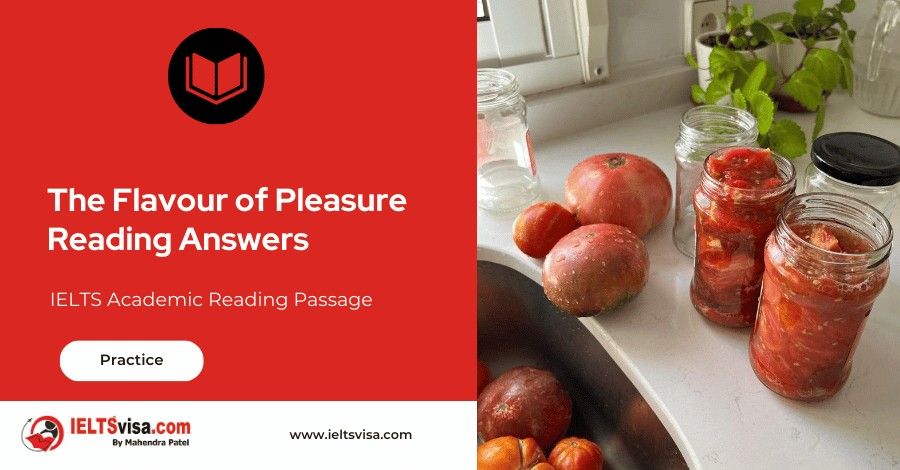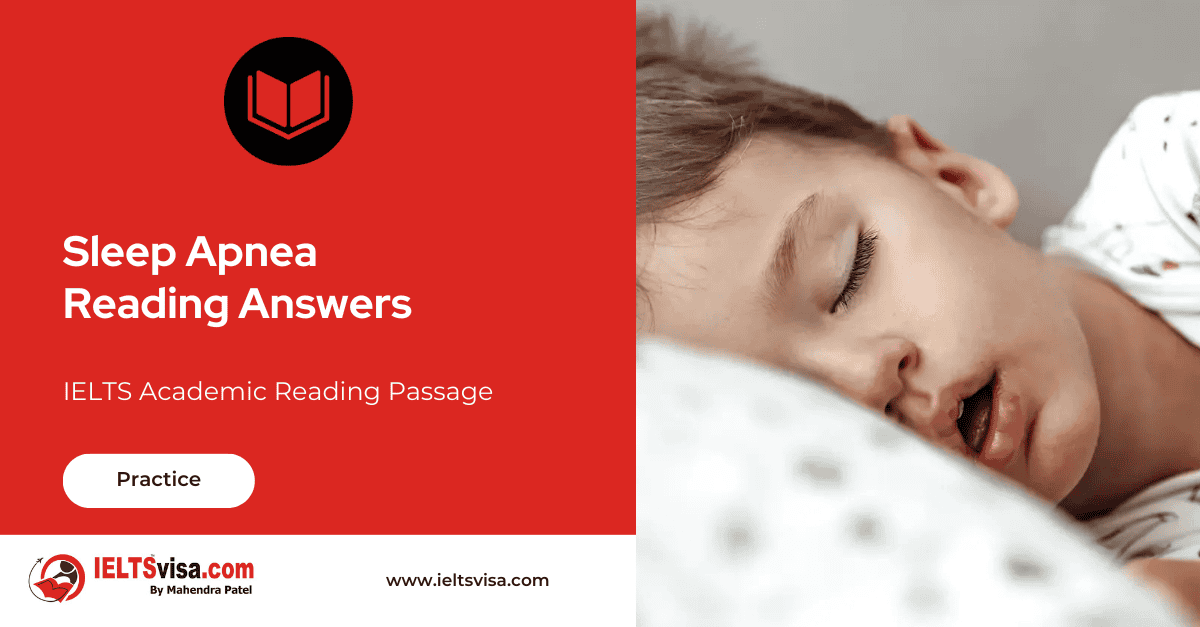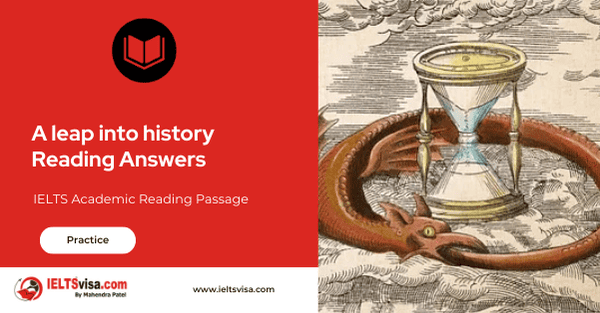The Flavour of Pleasure Reading Answers
IELTS Academic Reading Passage
No matter how much we talk about tasting our favourite flavours, relishing them really depends on a combined input from our senses that we experience through mouth, tongue and nose. The taste, texture, and feel of food are what we tend to focus on, but most important are the slight puffs of air as we chew our food – what scientists call “retronasal smell”.
Certainly, our mouths and tongues have taste buds, which are receptors for the five basic flavours: sweet, salty, sour, bitter, and umami, or what is more commonly referred to as savoury. But our tongues are inaccurate instruments as far as flavour is concerned. They evolved to recognise only a few basic tastes in order to quickly identify toxins, which in nature are often quite bitter or acidly sour.
All the complexity, nuance, and pleasure of flavour come from the sense of smell operating in the back of the nose. It is there that a kind of alchemy occurs when we breathe up and out the passing whiffs of our chewed food. Unlike a hound’s skull with its extra-long nose, which evolved specifically to detect external smells, our noses have evolved to detect internal scents. Primates specialise in savouring the many millions of flavour combinations that they can create for their mouths.
Taste without retronasal smell is not much help in recognising flavour. Smell has been the most poorly understood of our senses and only recently has neuroscience, led by Yale University’s Gordon Shepherd, begun to shed light on its workings. Shepherd has come up with the term ‘neurogastronomy’ to link the disciplines of food science, neurology, psychology. and anthropology with the savoury elements of eating, one of the most enjoyed of human experiences.
In many ways, he is discovering that smell is rather like face recognition. The visual system detects patterns of light and dark and, building on experience, the brain creates a spatial map. It uses this to interpret the interrelationship of the patterns and draw conclusions that allow us to identify people and places. In the same way, we use patterns and ratios to detect both new and familiar flavours. As we eat, specialised receptors in the back of the nose detect the air molecules in our meals. From signals sent by the receptors, the brain understands smells as complex spatial patterns. Using these, as well as input from the other senses, it constructs the idea of specific flavours.
This ability to appreciate specific aromas turns out to be central to the pleasure we get from food, much as our ability to recognise individuals is central to the pleasures of social life. The process is so embedded in our brains that our sense of smell is critical to our enjoyment of life at large. Recent studies show that people who lose the ability to smell become socially insecure, and their overall level of happiness plummets.
Working out the role of smell in flavor interests food scientists, psychologists, and cooks alike. The relatively new discipline of molecular gastronomy, especially, relies on understanding the mechanics of aroma to manipulate flavor for maximum impact. In this discipline, chefs use their knowledge of the chemical changes that take place during cooking to produce eating pleasures that go beyond the ‘ordinary’.
However, whereas molecular gastronomy is concerned primarily with the food or ‘smell’ molecules, neurogastronomy is more focused on the receptor molecules and the brain’s spatial images for smell. Smell stimuli form what Shepherd terms ‘odor objects’, stored as memories, and these have a direct link with our emotions. The brain creates images of unfamiliar smells by relating them to other more familiar smells. Go back in history and this was part of our survival repertoire; like most animals, we drew on our sense of smell, when visual information was scarce, to single out prey.
Thus the brain’s flavor-recognition system is a highly complex perceptual mechanism that puts all five senses to work in various combinations. Visual and sound cues contribute, such as crunching, as does touch, including the texture and feel of food on our lips and in our mouths. Then there are the taste receptors, and finally, the smell, activated when we inhale. The engagement of our emotions can be readily illustrated when we picture some of the wide- ranging facial expressions that are elicited by various foods ~ many of them hard-wired into our brains at birth. Consider the response to the sharpness of a lemon and compare that with the face that is welcoming the smooth wonder of chocolate.
The flavor-sensing system, ever receptive to new combinations, helps to keep our brains active and flexible. It also has the power to shape our desires and ultimately our bodies. On the horizon we have the positive application of neurogastronomy: manipulating flavor to curb our appetites.
Questions 1-5
Complete the notes below.
Write NO MORE THAN TWO WORDS from the passage.
1 According to scientists, the term……………..characterises the most critical factor in appreciating flavour.
2 ‘Savoury’ is a better-known word for ………………..
3 The tongue was originally developed to recognize the unpleasant taste of ………………
4 Human nasal cavities recognize………………much better than external ones.
5 Gordon Shepherd uses the word ‘neurogastronomy’ to draw together a number of ………………… related to the enjoyment of eating.
Questions 6-9
Complete the table below.
Write NO MORE THAN TWO WORDS from the passage.
|
Face Recognition |
Patterns of dark and light are used to put together a
6 ………… |
The brain identifies faces. |
Facial recognition is key to our enjoyment of 7……………….. |
|
Smell |
Receptors recognize the
8…………. in food |
The brain identifies
certain 9…………… |
Smell is key to our
enjoyment of food |
Questions 10-13
Answer the questions below.
Choose NO MORE THAN ONE WORD from the text for each answer.
10 In what form does the brain store ‘odor objects?
11 When seeing was difficult, what did we use our sense of smell to find?
12 Which food item illustrates how flavour and positive emotion are linked?
13 What could be controlled in the future through flavour manipulation?

Solution For: The Flavour of Pleasure
Reading Answers
| 1. (retronasal) smell | 5. Disciplines | 9. flavors/flavours | 13. Appetites |
| 2. Umami | 6. Spatial map | 10. Memories | |
| 3. Toxins | 7. Social life | 11. Prey | |
| 4. Internal scents/smells | 8. (air) molecules | 12. Chocolate |
Review and Practice
- Regularly practice with IELTS reading samples and time yourself to get used to the pressure of the exam.
- Review your mistakes to understand where you went wrong and how to avoid similar errors in the future.
Our Books
Master IELTS Speaking Part 1
IELTS Writing Task 1 Book
IELTS Writing Task 2 Book
The Flavour of Pleasure Reading Answers Explanation
Comin Soon
Practice IELTS Other Modules
IELTS Listening
The IELTS Listening test assesses how well you can understand spoken English in various contexts. It lasts about 30 minutes and is divided into four sections with a total of 40 questions. The listening tasks become increasingly difficult as the test progresses.
IELTS Academic Reading
The IELTS Academic Reading section assesses your ability to understand and interpret a variety of texts in academic settings. It is designed to evaluate a range of reading skills, including skimming for gist, reading for main ideas, reading for detail, understanding inferences, and recognizing a writer's opinions and arguments.
IELTS Speaking
The IELTS Speaking test assesses your ability to communicate in English on everyday topics. It lasts 11-14 minutes and consists of three parts: introduction, cue card, and a discussion based on the cue card topic.
IELTS General Reading
IELTS General Reading tests your ability to understand and interpret various types of texts. Here are some key areas and types of content you can expect to encounter in the reading section, along with tips for effective preparation.
IELTS Academic Writing Task 1
In IELTS Academic Writing Task 1, you are presented with a visual representation of information, such as graphs, charts, tables, or diagrams, and you are required to summarize, compare, or explain the data in your own words.
IELTS General Writing Task 1
In IELTS General Writing Task 1, you are required to write a letter based on a given situation. The letter can be formal, semi-formal, or informal, depending on the prompt. Here’s a breakdown of the key components to include in your letter
IELTS Academic Writing Task 2
In IELTS Academic Writing Task 2, you are required to write an essay in response to a question or topic. Here’s a guide to help you understand the essential elements of this task
IELTS Exam Tips
To succeed in the IELTS exam, practice regularly, familiarize yourself with the test format, improve your vocabulary, develop time management skills, and take mock tests to build confidence.
Grammer for IELTS
Grammar is the foundation of effective communication in English. Understanding tense usage, subject-verb agreement, and sentence structure enhances clarity and coherence in writing and speaking.
Vocabulary for IELTS
Vocabulary plays a crucial role in the IELTS (International English Language Testing System) exam, especially in the Speaking and Writing sections. Here’s an overview of why vocabulary is important and how it impacts your performance
RECENT IELTS SAMPLES QUESTIONS AND ANSWERS
Ditching that Saintly Image
A. Charities, it is still widely believed, are separate from the government, staffed entirely...
Sleep apnea
1. Sleep apnea is a common sleeping disorder. It affects a number of adults comparable to the...
A leap into history
A Between the Inishowen peninsula, north west of Derry, and the Glens of Antrim, in the east...
Caves
Caves are natural underground spaces commonly those into which man can enter. There are three...
Cure-all Pills: Myths or Reality?
Browse the shelves of any health food shop or pharmacy and you’ll find dozens of dietary...
Dawn Of The Robots
A. At first glance, it appeared to be a typical suburban road accident. A Land Rover...













